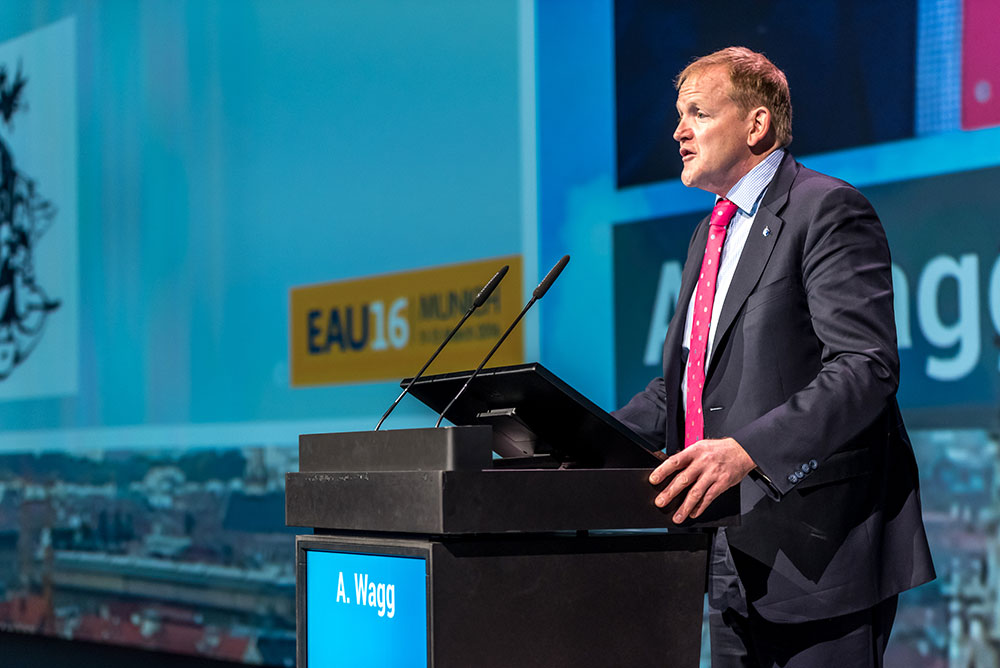Treating the elderly: Challenges and prospects
Treating the elderly for urological disorders such as Lower Urinary Tract (LUT) problems can pose challenges with treatment and diagnostics issues further complicated with the lack of evidence-based medicine.
Plenary Session 3 took up the question of providing optimal care to patients with the theme “Ageing and the Lower Urinary Tract,” chaired by Professors Dirk De Ridder (BE) and Francesco Montorsi (IT). State-of-the-art lectures were given by Prof. Alan Wein (US), Dr. Adrian Wagg (CA) and Dr. Jean-Nicolas Cornu (FR).
Wein presented a comprehensive overview on the pathophysiology of ageing with emphasis on the changes in the LUT among the elderly.
“The state of the function of the LUT in an elderly individual is the result of an interaction (collision) between potential predisposing factors over which we have no or partial control,” said Wein as he noted that these are “facts of life” which occur in the physical level.
Among these physical age-related changes involve morphology, metabolism, hormonal environment, physiology of the lower urinary tract and pelvic floor and cerebral control and integration. He enumerated a list of disorders that often overtake the elderly such as lack of bladder control which leads to common incontinence problems.
“The bladder becomes more susceptible,” Wagg said adding that amongst women previous pelvic surgery, a difficult childbirth and trauma can later on lead to or exacerbate existing pelvic disorders. “Pelvic organ prolapse affects around 50% of women over the age of 50 years,” he said.
Wagg followed up on the physical disorders discussed by Wein, by examining the various medical drugs which may offer treatment or palliative care to the elderly who suffer from LUT dysfunction.
“The prevalence of incontinence is linked to age… and healthy practices in mid-life is shown to have a likely impact to control later incidence of disorders,” said Wagg. “It could be that the next catch-phrase would be preventive geriatrics.”
He said doctors and healthcare professional are often faced with the question which are the “good” and effective drugs for LUTS dysfunction while at the same time being faced by the lack of evidence or empiric observation. He called it the “evidence-practice gap” which often presents dilemmas in everyday clinical practice.
He then mentioned pharmacological treatment for the elderly which found some support in studies. “There are data supporting the efficacy of antimuscarinics drugs in community-dwelling older people (older than 65 years but younger than 75).”
He also mentioned FORTA (Fit fOR The Aged Classification) which was introduced in 2008 and aims to guide physicians in screening for inappropriate or harmful medicines and drug omissions in older patients.
“There is currently a FORTA list of around 200 different drugs and drug groups for more than 20 therapeutic areas with relevance to older people,” said Wagg.
“Although we have more evidence, we need still more in older age groups, from pragmatic clinical trials. And we need to proactively seek treatment-related adverse events (TEAEs),” said Wagg in his concluding message. “We have acceptable drugs for the majority but more information to guide is needed to guide optimal therapies choices.”
Cornu spoke on the current surgical treatment for Benign Prostatic Obstruction (BPO) and gave insights on the characteristics of elderly patients, the aims of invasive treatment for men over 75 years, and the available tools and results from literature.
He cautioned that doctors need to be careful with surgical options since the elderly do not only have existing morbidities but are also vulnerable to physical changes or deterioration while being hospitalized, post-surgery, such as changes in blood pressure, and susceptibility to thromboembolism and loss of muscle mass.
“Be most careful about patient characteristics and treat properly if there is no red flag,” said Cornu. “Reduce hospital stay and consider detrusor underactivity as part of decision-making.”


